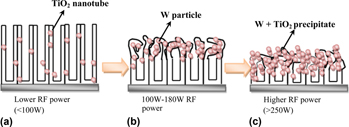Crossref Citations
This article has been cited by the following publications. This list is generated based on data provided by
Crossref.
Lai, C.W.
and
Sreekantana, S.
2012.
Higher water splitting hydrogen generation rate for single crystalline anatase phase of TiO2nanotube arrays.
The European Physical Journal Applied Physics,
Vol. 59,
Issue. 2,
p.
20403.
LAI, CHIN WEI
and
SREEKANTAN, SRIMALA
2012.
OPTIMIZED SPUTTERING POWER TO INCORPORATE WO3 INTO C–TiO2 NANOTUBES FOR HIGHLY VISIBLE PHOTORESPONSE PERFORMANCE.
Nano,
Vol. 07,
Issue. 06,
p.
1250051.
Lai, Chin Wei
and
Sreekantan, Srimala
2013.
Study of WO3 incorporated C-TiO2 nanotubes for efficient visible light driven water splitting performance.
Journal of Alloys and Compounds,
Vol. 547,
Issue. ,
p.
43.
Lai, Chin Wei
and
Sreekantan, Srimala
2013.
Incorporation of WO3 species into TiO2 nanotubes via wet impregnation and their water-splitting performance.
Electrochimica Acta,
Vol. 87,
Issue. ,
p.
294.
Lai, Chin Wei
and
Sreekantan, Srimala
2013.
Effect of heat treatment on WO3-loaded TiO2 nanotubes for hydrogen generation via enhanced water splitting.
Materials Science in Semiconductor Processing,
Vol. 16,
Issue. 3,
p.
947.
Reyes-Gil, Karla R.
and
Robinson, David B.
2013.
WO3-Enhanced TiO2 Nanotube Photoanodes for Solar Water Splitting with Simultaneous Wastewater Treatment.
ACS Applied Materials & Interfaces,
Vol. 5,
Issue. 23,
p.
12400.
Lai, Chin Wei
and
Sreekantan, Srimala
2013.
Preparation of hybrid WO3–TiO2 nanotube photoelectrodes using anodization and wet impregnation: Improved water-splitting hydrogen generation performance.
International Journal of Hydrogen Energy,
Vol. 38,
Issue. 5,
p.
2156.
Lai, Chin Wei
and
Sreekantan, Srimala
2013.
Fabrication of WO3 nanostructures by anodization method for visible-light driven water splitting and photodegradation of methyl orange.
Materials Science in Semiconductor Processing,
Vol. 16,
Issue. 2,
p.
303.
Sreekantan, Srimala
Zaki, Syazwani Mohd.
Lai, Chin Wei
and
Tzu, Teoh Wah
2014.
Copper-incorporated titania nanotubes for effective lead ion removal.
Materials Science in Semiconductor Processing,
Vol. 26,
Issue. ,
p.
620.
Lai, Chin Wei
Juan, Joon Ching
Ko, Weon Bae
and
Bee Abd Hamid, Sharifah
2014.
An Overview: Recent Development of Titanium Oxide Nanotubes as Photocatalyst for Dye Degradation.
International Journal of Photoenergy,
Vol. 2014,
Issue. ,
p.
1.
Lai, Chin Wei
and
Lau, Kung Shiuh
2014.
Development of Hybrid WO<sub>3</sub>-TiO<sub>2</sub> Nanotubes for Solar Hydrogen Generation via Water Electrolysis.
Advanced Materials Research,
Vol. 925,
Issue. ,
p.
474.
Reyes-Gil, Karla R.
Stephens, Zachary D.
Stavila, Vitalie
and
Robinson, David B.
2015.
Composite WO3/TiO2 Nanostructures for High Electrochromic Activity.
ACS Applied Materials & Interfaces,
Vol. 7,
Issue. 4,
p.
2202.
Migowski, Pedro
and
Feil, Adriano F.
2016.
Uses of Physical Vapor Deposition Processes in Photoelectrochemical Water Splitting Systems.
Recyclable Catalysis,
Vol. 3,
Issue. 1,
p.
1.
Prabhu, S.
Cindrella, L.
Kwon, Oh Joong
and
Mohanraju, K.
2018.
Photoelectrochemical and photocatalytic activity of TiO2-WO3 heterostructures boosted by mutual interaction.
Materials Science in Semiconductor Processing,
Vol. 88,
Issue. ,
p.
10.
Lai, Chin Wei
Lau, Kung Shiuh
and
Chou, Pui May
2019.
CdSe/TiO2 nanotubes for enhanced photoelectrochemical activity under solar illumination: Influence of soaking time in CdSe bath solution.
Chemical Physics Letters,
Vol. 714,
Issue. ,
p.
6.



